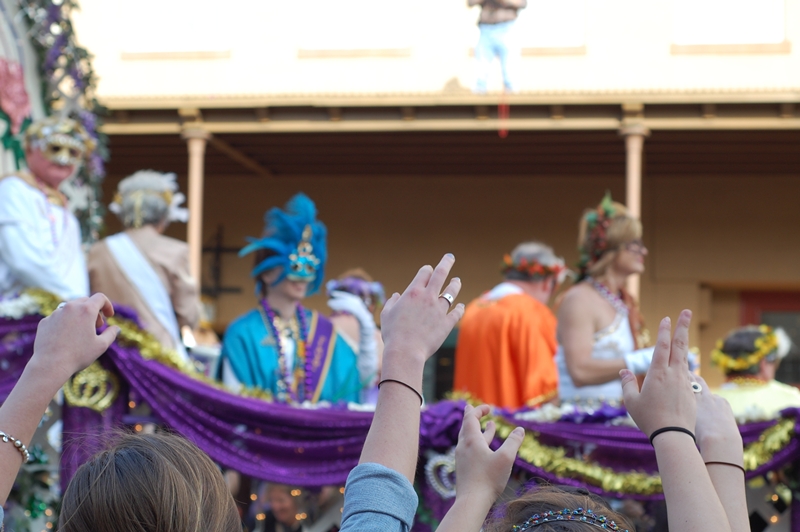
Mardi Gras is one of America’s most well-known celebrations, commonly associated with debauchery and Bourbon Street in New Orleans. But the Big Easy isn’t the only place that has Mardi Gras!
This post contains affiliate links.
Table of Contents
The History of Mardi Gras
People use the term Mardi Gras to mean Fat Tuesday. But in actuality, it’s a part of a month-long Carnival celebration that includes multiple parades. The name comes from the French and the early celebrations involved indulging in rich or fatty foods before giving them up until Easter.
The first Mardi Gras in Louisiana took place near New Orleans in 1699 when French explorers celebrated in a spot they called Point du Mardi Gras. The event spread throughout the French-occupied territories in the New World.
In the 1800s, the first appearance of masked balls and parades occurred, which have become commonplace throughout Mardi Gras festivities nationwide. Krewes organize the events using different themes in the days leading up to Lent.
In New Orleans, the Krewe of Rex was established in 1872 and set traditions that are now common, including the incorporation of the colors green, yellow, and purple.
Learning About Mardi Gras in New Orleans

Visiting New Orleans outside of Carnival? You can still experience Mardi Gras year-round. Mardi Gras World is one of the most popular attractions, showcasing the work that goes into creating floats. The Mardi Gras Museum of Costume and Culture, The Presbytère, and the Backstreet Cultural Museum provide added context.
Antoine’s and Arnaud’s are two local restaurants that have lavish costumes on display. New Orleans Mardi Gras Tour: Interactive Parade Experience & Mardi Gras World Tour with complimentary cocktail also gives you the full experience.
Louisiana Mardi Gras
Baton Rouge

Baton Rouge holds annual Mardi Gras celebrations run for two weeks in early February. There are dozens of parades organized by different krewes, including one for pets, held in different neighborhoods. Some are invite-only while others are open to the public.
For example, the Krewe of Oshun Parade in historic Scotlandville focuses on the city’s African American traditions including appearances by Mardi Gras Indians and the Southern University Human Jukebox marching band. Mid City Gras is in the Mid City neighborhood and has family-friendly floats and handmade throws.
While not a parade, a fun tradition in Baton Rouge is the wooden flamingos in the University Lakes at Louisiana State University. Students make their way into the water to grab them and display them at their homes.
The Capitol Park Museum has a lot of information about Mardi Gras traditions around the state, including colorful costumes and different aspects from each area.
Lafayette

Lafayette is in the heart of Cajun Country, making its celebrations different than other parts of Louisiana. Courir de Mardi Gras is one aspect, which includes costumed men and women on horseback. There are also chicken races popular with kids.
Parades are held in central Lafayette and in neighboring parishes, including St. Landry, Iberia, St. Mary, St. Martin, Acadia, Evangeline, Vermilion, and Jefferson Davis.
Each one has something different. The Krewe de Canailles Walking Parade requires man-powered floats and environmentally friendly throws. There’s also a children’s parade, along with Mardi Gras balls, king cake, Mardi Gras Indians, and the krewe kings and queens.
Lake Charles

Lake Charles has Southwest Louisiana’s largest Mardi Gras festivities. The events begin in early January and run through the end of February. The Krewe of Krewes Parade is one of the oldest in town, which features over 100 floats.
There’s also the Lake Charles Mardi Gras Boat Parade, located on the lakefront. Young ones enjoy the Children’s Parade while furry friends can take part in the Krewe of Barkus Parade.
Learn about Lake Charles’ traditions at the Mardi Gras Museum of Imperial Calcasieu. Set in a historic schoolhouse, this museum has exhibits on costumes and memorabilia from local krewes.
Alabama Mardi Gras
Mobile

Mobile is another French settlement with deep roots in Mardi Gras. They also claim to have the earliest celebrations in the country, dating back to 1703. Festivities run for two and a half weeks before Fat Tuesday. What you will often find tossed from floats are Moon Pies, a Southern-made snack. There’s also Joe Cain Day, named for the founder of the celebrations.
You probably won’t get into any of the Mardi Gras balls unless you know someone in the krewe, but the parades are open to all. They’re in both downtown Mobile and nearby areas like Orange Beach.
But you can go to the Mobile Carnival Museum, the only museum in the country devoted to the history of Carnival. It has rooms of the lavish attire the court of various krewes wear every season. You’ll also get to see how the celebration has evolved over the last 100+ years. Get your Skip the Line Mobile Carnival Museum ticket before you go. The History Museum of Mobile also has an exhibit on the festivities.
Mississippi Mardi Gras
Gulf Coast

Mardi Gras celebrations are also found in the towns of the Mississippi Gulf Coast. The first parade took place in 1908 with 17 floats. Today, there are over 20 parades held among the 44 miles of coastline starting on February 1. They also have Moon Pies like in neighboring Alabama.
Biloxi has dozens of events on its own, including parades and parties for seniors, children, and those with special needs. There’s also a pet parade. Ocean Springs hosts Krewe Unique and the Krewe of Diamonds and also has delicious king cake at French Kiss Pastries.
Bay St. Louis has hosted Mardi Gras since 1896, which you can learn about at the Bay St Louis Mardi Gras Museum. They have the Mystic Krewe of the Seahorse and Krewe of Diamonds parades.
Florida Mardi Gras
Orlando
Believe it or not, Orlando has its own Mardi Gras celebration! Universal Orlando Resort hosts an annual event through the months of February, March, and April that features special menu items and confetti-filled parades where guests can ride on floats and toss beads.
The event combines Carnaval traditions from around the world as well, including Europe and South America. The park even hosts concerts from big-name artists during this time. It’s one of the best seasons to visit the theme park.
Panama City and Panama City Beach

Both Panama City and neighboring Panama City Beach have Mardi Gras celebrations. In fact, St. Andrews Mardi Gras, in one of Panama City’s oldest neighborhoods, has been going on since 1997.
The Krewe of St. Andrews has over 180 members and raises funds for local charities and supports college scholarships with family-friendly events. But there’s more than just the parade, which has a different theme every year. There are also activities for kids, food, and live music. A king and queen are also chosen.
In Panama City Beach, Mardi Gras is held February 21-22 and is centered around the Krewe of Dominique Youx‘s great Mardi Gras at the Beach parade. There’s a kids parade, live music, and a second line.
Pensacola

Pensacola, along the Florida Panhandle, has its own Mardi Gras festivities. They boast over 50 krewes, including one from the beloved Flora-Bama Lounge and another made up of Parrotheads, also known as Jimmy Buffet superfans.
The Pensacola Mardi Gras events include floats, parades, dance parties, live music, and Mardi Gras balls. It also serves as a fundraiser and community event with a chili cookoff, food drive, and diaper drive.
What to Wear to Mardi Gras

You don’t need to buy beads because they’re purchased by the krewes throwing them from floats. Some people take their outfits very seriously, rocking handmade costumes based on the krewe theme. Remember that temperatures might still be chilly!
But if it’s your first time, you can assemble an easy outfit from online sellers. In addition to the links below, Louisiana companies like Dirty Coast and Fleurty Girl have fun clothing and accessories. Our friends at Traveler Broads have a helpful post for visitors to New Orleans.
 |  |  |  |
| Mardi Gras Tiered Tassels, $9 | Mardi Gras Flip Sequin Jacket, $59.99 | Mardi Gras Shirt – Alligator, $20 | Mardi Gras Fanny Pack, $20 |
PIN IT



Leave a Reply